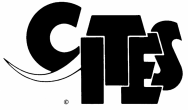CITES Parties gather online to review new tool to boost government-led efforts to reduce demand for illegally sourced wildlife
Geneva/Cambridge, 14 June 2021 – The demand for illegal wildlife products is one of the leading causes for the decline of many species, including elephants, rhinoceroses, great apes, marine turtles, pangolins, and tigers, but also less known species of flora and fauna such as cycads, rosewoods, seahorses, tortoises, parrots, ungulates.

Demand for illegally sourced wildlife and their products is driven by several different factors. Some of these species are sought after as status symbols, out of curiosity, or for the novelty or as collectors’ items. Others are purchased to be kept as exotic pets, or for food, medicine, furniture, or fashion.
The CITES Secretariat, in collaboration with TRAFFIC, is hosting a two-day workshop to review the draft CITES Guidance on Demand Reduction Strategies for Illegal Wildlife Trade and to provide training in behaviour change techniques aimed at reducing demand for illegally sourced wildlife products among consumers. Representatives of 20 CITES Parties are joining participants from civil society, the private sector and academia to share state of the art knowledge and lessons learnt in this domain.
The development of the Guidance thus aims to support CITES Parties in implementing targeted demand reduction strategies through a range of behaviour change techniques that can address demand for illegal products and the multiple motivations behind it.

The workshop delivers on Decision 18.86, which was adopted at the 18th meeting of the Conference of the Parties to CITES in 2019, and which called on the CITES Secretariat to develop guidance for demand reduction and submit for the Parties’ review.
The workshop is expected to bring together more than 100 participants from around the world in a global discussion about how to effectively reduce the demand associated with the overexploitation of and illegal trade in around 7,000 CITES-listed species.
In her remarks opening the workshop, CITES Secretary-General Ivonne Higuero said: “Responding to illicit trafficking in wildlife and associated crimes, requires deploying all possible efforts to enforce the law and ensuring that relevant agencies are able to detect and punish criminals involved in that trafficking. It also involves promoting demand reduction strategies in consuming countries and providing incentives to rural communities to conserve wildlife in countries rich in biodiversity. The development of the CITES Guidance on demand reduction is a crucial response of CITES in order to support government-led and well-targeted strategies to achieve behavioural change.”
Social and behavioural change approaches are among some of the most powerful tools we have in affecting lasting change for threatened species. CITES continues to show real leadership in this space and we anticipate varied and vibrant inputs from the workshop. The rich discussions from this forum should help Parties deliver high-impact campaigns and measurable progress in halting the catastrophic decline of endangered and illegally traded species.”
Gayle Burgess,TRAFFIC’s Behaviour Change Programme Leader
The development of the Guidance is part of the ongoing process through which the CITES Secretariat supports Parties’ efforts towards demand reduction. The Secretariat has previously organized a survey to compile and learn from Parties’ best practices in terms of demand reduction initiatives, the challenges they face in implementing these, and their specific needs in terms of capacity-building. Parties reviewed the findings of the survey during a dedicated workshop.
The Guidance introduces a Five Step Framework and 10 Behaviour Change Benchmarks. It will enable non-specialists to research, design, and deliver impactful and targeted behaviour change initiatives that successfully dissuade consumer desire and change buyer behaviour.
A revised version of the Guidance on Demand Reduction Strategies for Illegal Wildlife Trade, once approved by the Standing Committee, will be submitted for approval by the Parties at the 19th meeting of the Conference of the Parties to CITES in 2022.
The CITES Secretariat and TRAFFIC are grateful to the United States Fish and Wildlife Service for their generous financial contribution in support of the development of the Guidance and the delivery of this workshop, which is the largest gathering of Parties and experts aimed at discussing demand reduction in the context of CITES.
Convention on International Trade in Endangered Species of Wild Fauna and Flora (CITES)

The Convention on International Trade in Endangered Species of Wild Fauna and Flora, is an international agreement between governments that aims to ensure that international trade in specimens of wild animals and plants does not threaten their survival. Find out more here.
About TRAFFIC

TRAFFIC is a leading non-governmental organisation working to ensure that trade in wild species is legal and sustainable, for the benefit of the planet and people.


